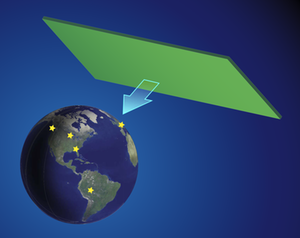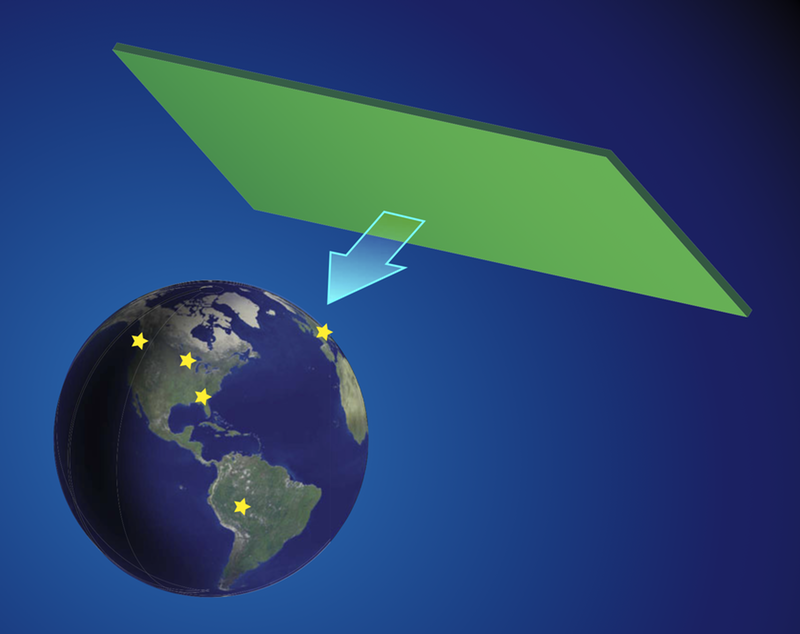Ground-Based Instruments Could Detect Cosmic Wall Structures
One of the potential explanations for the Universe’s mysterious dark matter and dark energy is a cosmic latticework of energetic “domain walls.” In Physical Review Letters, a team proposes the first method to directly detect these structures as the Earth passes through them. They find that if such walls exist and are abundant enough, they may be detectable by a relatively cheap set of sensitive magnetic-field detectors at several locations on Earth.
Dark matter affects the motions of galaxies, and dark energy is accelerating the expansion of the Universe. Together, these two components are estimated to make up some 95 percent of the mass-energy of the Universe, but their nature is a mystery.
To look for the missing stuff, experimenters have searched deep underground for dark matter particles streaming through the Earth. At the same time, theorists have been imagining other exotic phenomena, beyond new particles, that could tie up large amounts of energy almost invisibly. One possibility theorists have explored is a hypothetical field pervading the Universe that has one of several possible “ground state” values at every location in space. The idea is that in the hot, early Universe, the values were uncorrelated from place to place, but as the Universe cooled, large regions settled on a single value. However, between any two regions with different field values, there would be a “domain wall,” and the disruption of the field in the wall would require extra energy. These domains are analogous to those in a magnetic material like iron, where a large slab usually consists of many regions, each having a different magnetic field alignment.
Maxim Pospelov of the University of Victoria and the Perimeter Institute in Waterloo, Canada, and his colleagues wanted to see if cosmic domain walls could be detected. To account for dark matter or dark energy, Pospelov imagines domain walls that form a foamlike network whose arrangement has been more or less frozen since the early Universe cooled. For a particular choice of wall energy, the known density of dark matter and dark energy allowed Pospelov to estimate the possible size of the domains, or “bubbles,” in this foam.
If the Earth moves through this network at typical galactic speeds of a thousandth of the speed of light, then over the course of several years we could pass through many domain walls, Pospelov found. His collaborators on the new research, who build extraordinarily sensitive magnetic field detectors, considered whether these passages could be detected with current technology. The field is expected to exert a torque on atomic spins, just as magnetic fields do, so the team expressed their predictions in terms of an “effective” magnetic field. Using assumptions from other theories for the coupling of their hypothetical field to ordinary matter, the collaboration calculated that changes equivalent to perhaps a billionth of the earth’s magnetic field over a millisecond might be expected. The best modern magnetometers could indeed detect such a signal, the team reports, as well as the signals they expect for a range of other values for the theory’s parameters.
But any single event would be hard to distinguish from a random glitch in the electronics or a passing truck. To be confident in their conclusions, the team proposes looking for near-simultaneous events at perhaps five different locations around the Earth. A true domain-wall passage should show a characteristic time signature as it passes each location, they say. The experimenters have already used two existing magnetometers to show that they could detect such correlated events, and they hope to secure the modest funds needed to scale up the effort.
“It’s certainly somewhat outside of the mainstream,” says Pierre Sikivie of the University of Florida in Gainesville, who has explored related models, but he notes that experimenters need to cast a wide net in looking for dark matter and dark energy. He says a successful detection “would be very tantalizing,” but he wonders how researchers would deal with a one-time detection if it didn’t recur.
–Don Monroe
Don Monroe is a freelance science writer in Murray Hill, New Jersey.





